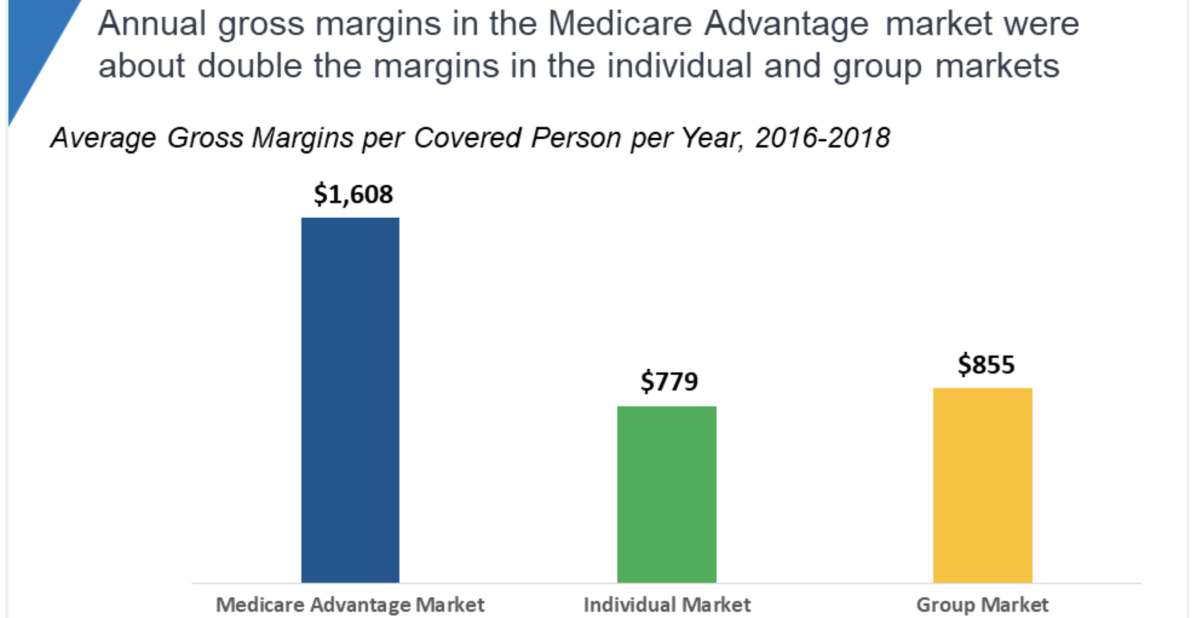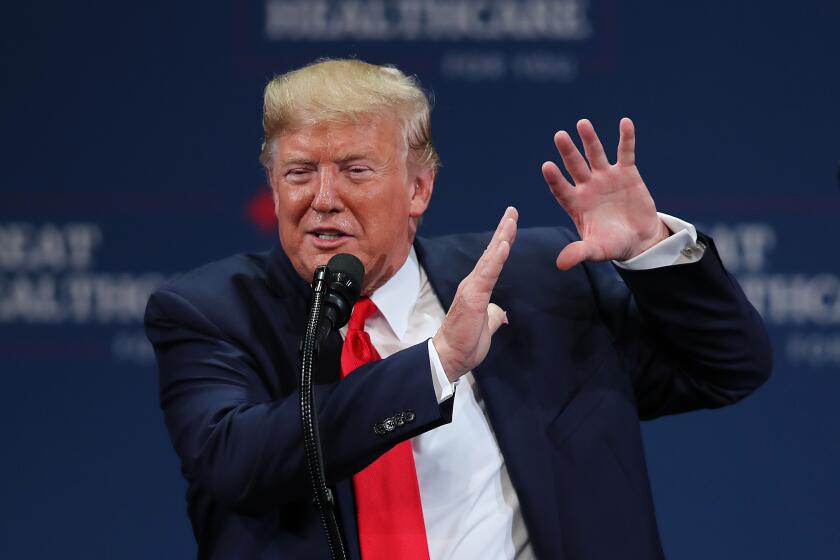Trump’s plan to ‘save’ Medicare would actually destroy it

- Share via
President Trump portrayed himself Thursday as the nation’s foremost defender of Medicare against what he termed the “socialist” “Medicare for all” proposals being offered by Democrats in Congress and on the presidential campaign trail.
“As long as I’m president, no one will lay a hand on your Medicare benefits,” Trump told an audience at a big Florida retirement community. During the day, he signed an executive order purportedly designed to “protect and improve” the program.
Here’s the truth of the matter: Trump’s executive order is a stealth attack on the very program he’s swearing to protect. Buried within the order is a provision that would destroy Medicare by driving its costs to an unsustainable level. At the same time, Trump is proposing to turn more of the program over to commercial insurers. Put simply, he’s proposing to privatize Medicare.
We’ll always protect the Medicare benefits you earned and paid for.
— President Trump
We’ll leave aside, for now, the misrepresentations of the various Medicare for all proposals bubbling through Trump’s speech and the executive order. The main point is that despite his claim to be the protector of Medicare, he’s merely associating himself with Republican proposals that have been aimed at disemboweling the program for years.
The victims will be the 60 million seniors who depend on Medicare for their healthcare. Their costs would go up, and their access to benefits shrink.
Let’s take these provisions in turn.
First is a mandate that the secretary of Health and Human Services examine raising traditional Medicare reimbursements to “more closely reflect the prices paid for services in [Medicare Advantage] and the commercial insurance market.”
Trump promotes ‘wellness’ programs, which don’t work and harm employees.
This would completely destroy the chief advantage Medicare has over commercial insurance — its cost structure. Medicare pays physicians on average about 40% less than commercial plans. Hospitals receive half to two-thirds from Medicare what they do from the private insurers, according to the Rand Corp.
Since one of the main factors driving up costs in American health is that we pay doctors and hospitals much more than they collect in other countries, this makes Medicare a signpost to more rational healthcare in the U.S.
To healthcare experts, this is no secret — the seminal paper on the topic was titled, “It’s the Prices, Stupid.” But it’s typically ignored in the hand-wringing debate over America’s ridiculously costly system, thanks to pressure from hospital, doctor and drug industry lobbyists.
Indeed, the feature of the Medicare for all proposal favored by Sens. Bernie Sanders (I-Vt.) and Elizabeth Warren (D-Mass.) that allows it to offer universal healthcare to all Americans, including expanded benefits, is that it would reduce reimbursements to current Medicare levels.
Trump’s proposal obviously would turn this on its head. In the words of Larry Levitt of the Kaiser Family Foundation, “that would increase the cost of Medicare enormously.” Put another way, if your intention is to bankrupt Medicare, you can hardly find a better way to do so than this.
Where would these increased costs fall? Almost certainly on enrollees, who would see their premiums soar for Medicare Part B. Trump’s executive order asserts that the change would “encourage more robust price competition, and otherwise ... inject market pricing into Medicare FFS [that is, “fee for service”] reimbursement.”
This is fatuous nonsense, since it’s hard to imagine that even the most robust price competition would bring reimbursement rates down to Medicare levels. In any event, it makes no sense to tie Medicare prices to a market model that so relentlessly inflates costs and thereby collects fatter profits for private participants.
USA Today gave President Trump a big gift Wednesday by publishing a largely fact-free attack on the “Medicare for all” plan promoted by Sen.
That brings us to the second shiv into Medicare buried in the executive order. That’s the promotion of Medicare Advantage plans. These plans are essentially privatized versions of traditional Medicare.
In traditional Medicare, the government sets reimbursement rates and coverage limitations and provides the program’s administration. Under Medicare Advantage, private insurers receive a set fee per enrollee from the government, but they can offer more services, such as vision and dental coverage, and a host of other come-ons to lure customers, such as acupuncture, health club discounts, transportation to the grocery store, even home pest control.
But there are drawbacks. Medicare Advantage plans impose narrow networks of doctors and hospitals on enrollees, and often don’t cover medical expenses while traveling. Most important, they’ve been accused of ripping off the government by charging well more than they should. A 2016 report by the Government Accountability Office placed the excess at $14.1 billion in 2013 alone.

Insurance companies love Medicare Advantage, because it’s a huge money maker. Annual average gross profits in that market per enrollee were $1,608 in 2016-18, according to the Kaiser Family Foundation, compared with $779 in the individual market and $855 in the group (that is, employer-sponsored) market.
Enrollees like Medicare Advantage, which now covers more than a third of all people eligible for Medicare. But that statistic should be approached carefully. Medicare Advantage is a device for cherry-picking the lowest-cost seniors out of the Medicare pool — they’re the seniors whose healthcare needs can be filled by a narrow network of doctors, and who can use blandishments such as gym memberships.
But that leaves the more expensive healthcare cases in the traditional Medicare pool, where costs, and therefore premiums, will be driven higher.
Some Medicare advocates don’t oppose Medicare Advantage in principle. “For some beneficiaries, it may be the most practical choice — at least while they are relatively young and healthy,” says the National Committee to Preserve Social Security and Medicare. But others, such as Nancy Altman of Social Security Works, see it as “stealth privatization intended to undermine traditional Medicare.”
The Trump administration has been pushing Medicare Advantage plans assiduously, in a way that may suck in seniors for whom they’re the wrong choice. Trump’s executive order would turbocharge this trend, and we should ask: Why?
The Trump administration has shown nothing but hostility to the very idea that healthcare is a right for all Americans; Trump just mouths platitudes and claims that he’ll be the healthcare hero. Look behind the words, and the intention is clear.
“My administration is standing up for American seniors,” Trump said Thursday. “And we’ll always protect the Medicare benefits you earned and paid for.” But his goal isn’t “to ensure the world’s best healthcare for all Americans,” as he claimed; it’s to make the flaws in the existing system much, much worse, so that nothing remains.
More to Read
Inside the business of entertainment
The Wide Shot brings you news, analysis and insights on everything from streaming wars to production — and what it all means for the future.
You may occasionally receive promotional content from the Los Angeles Times.












